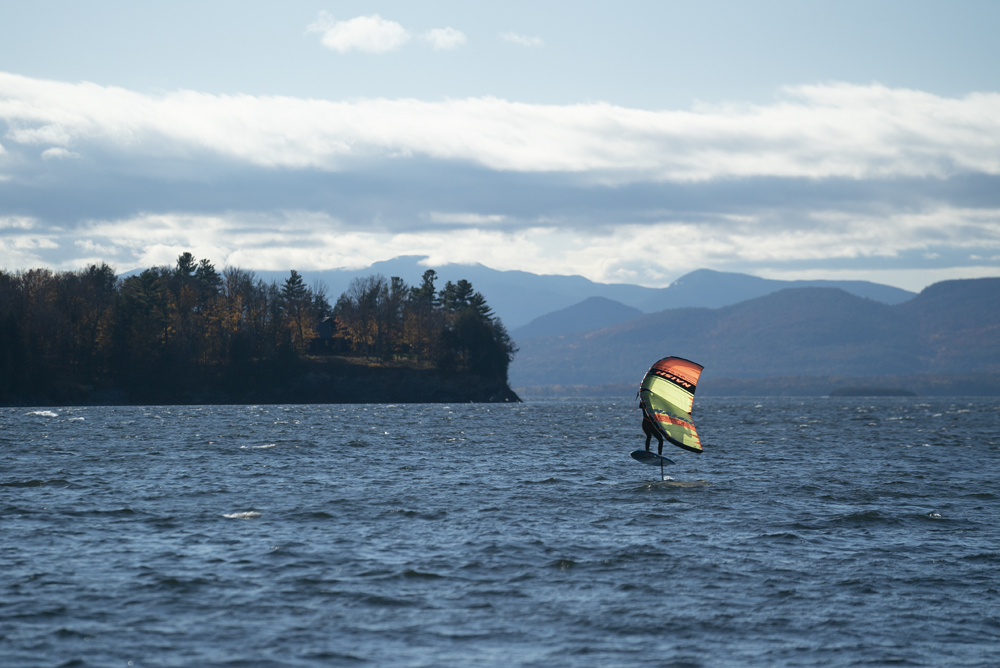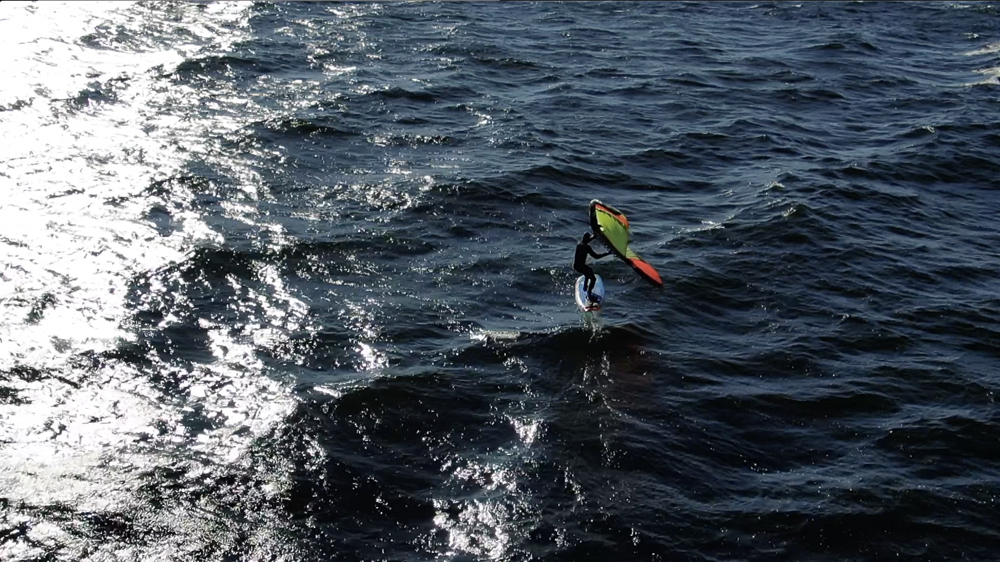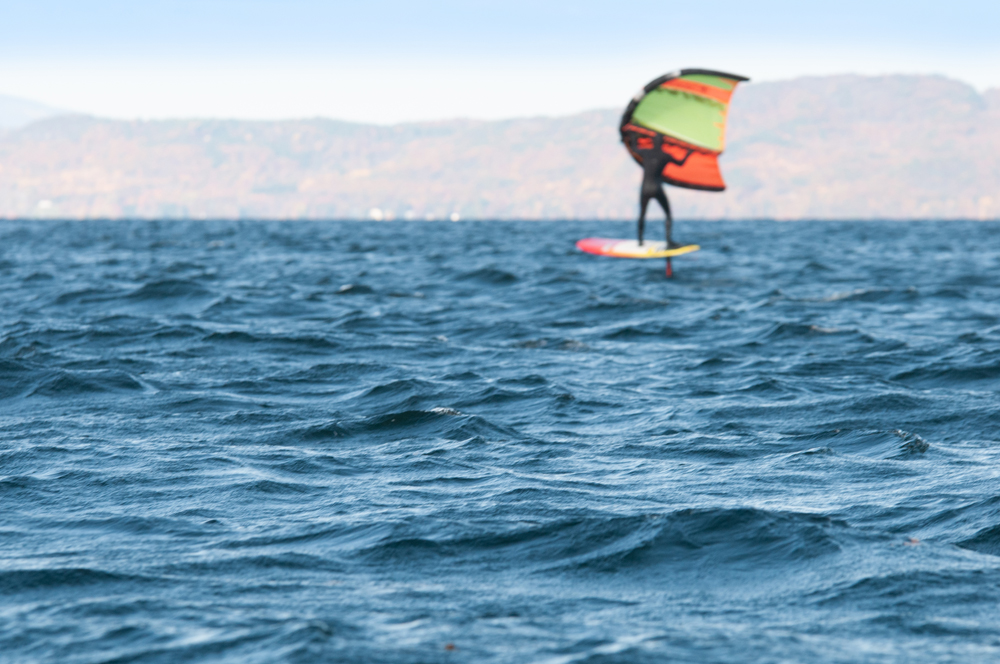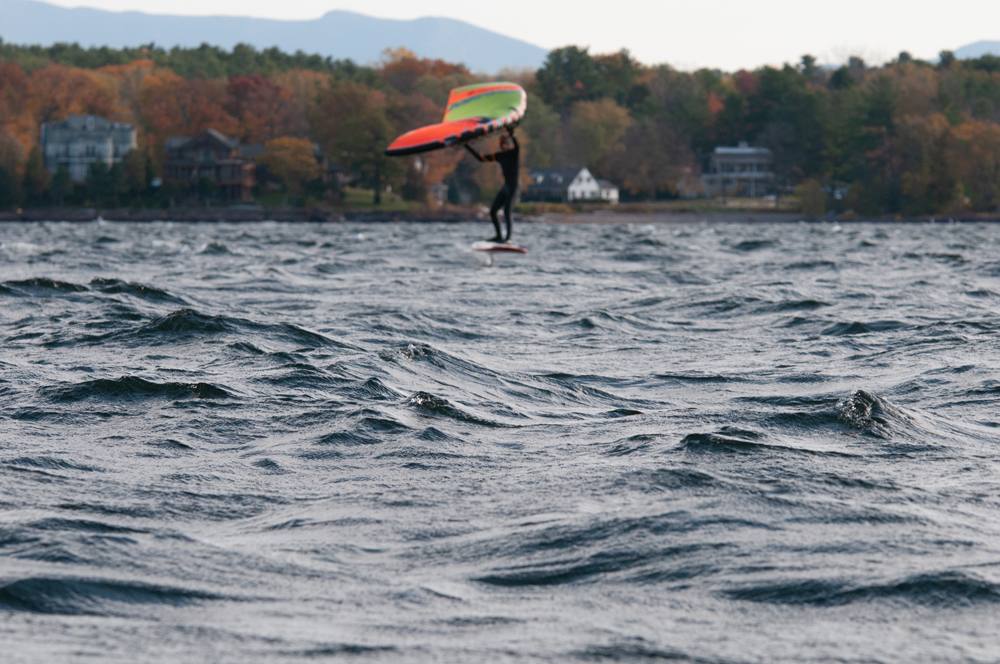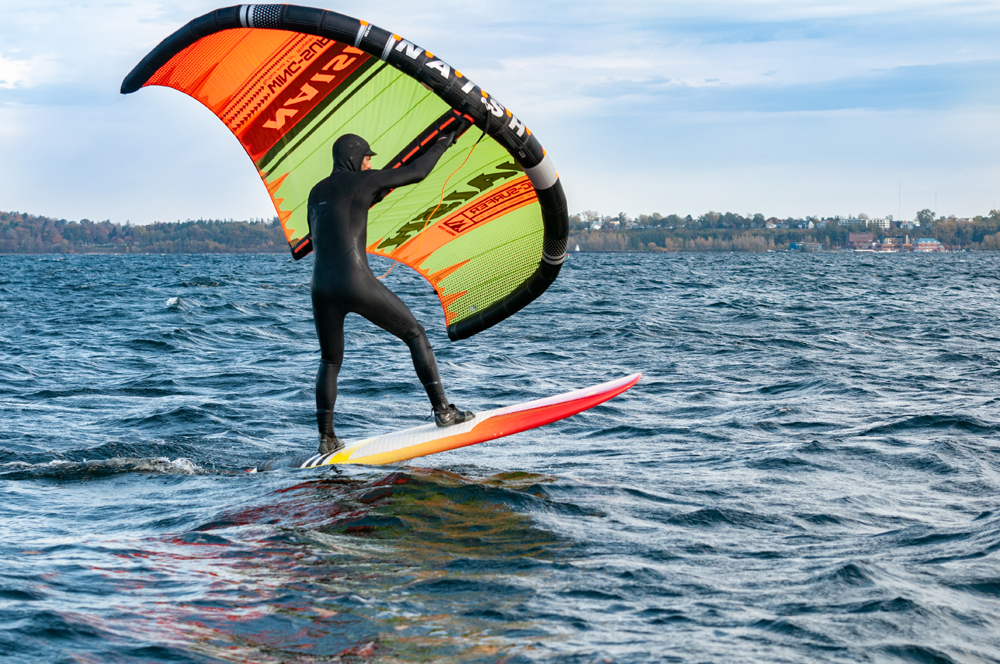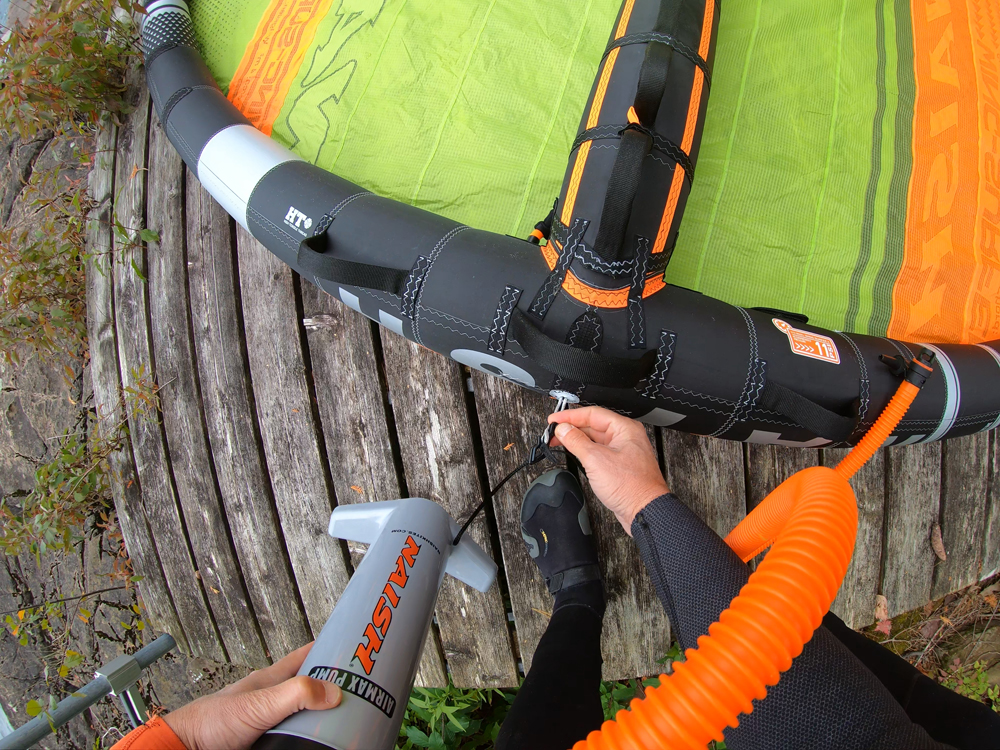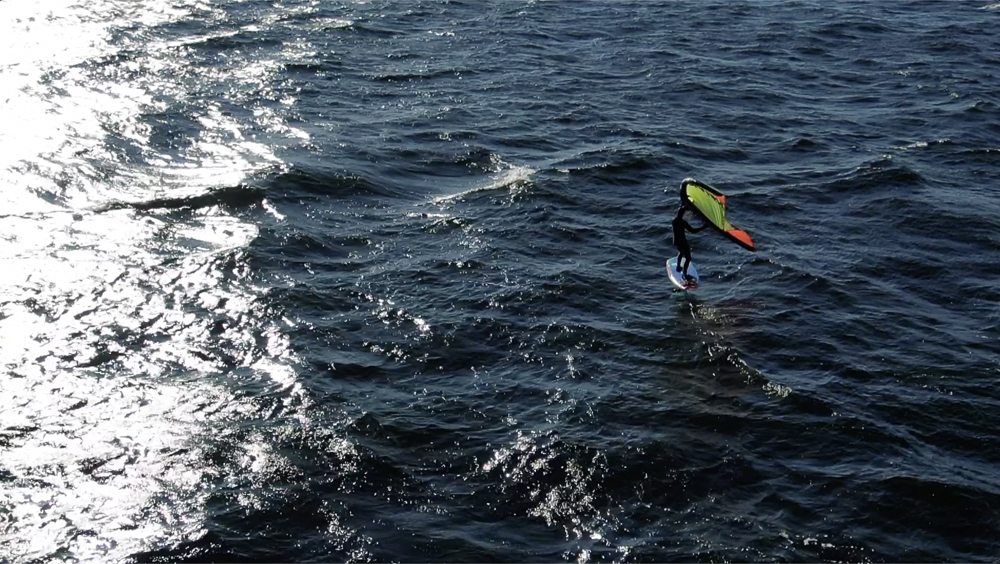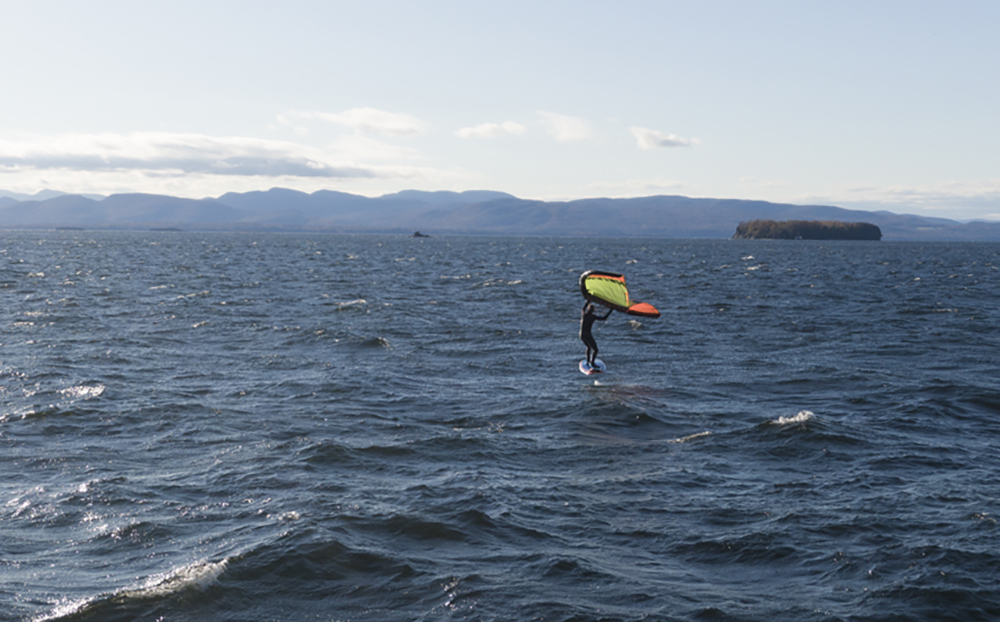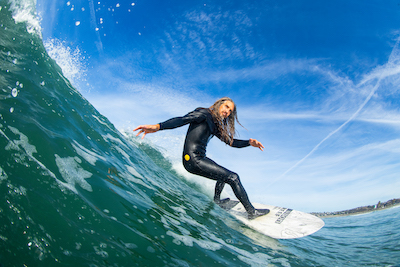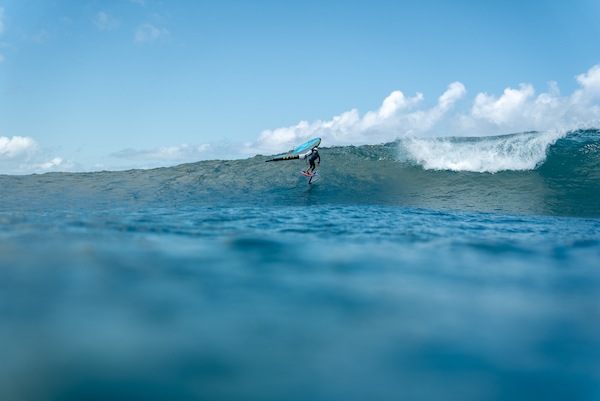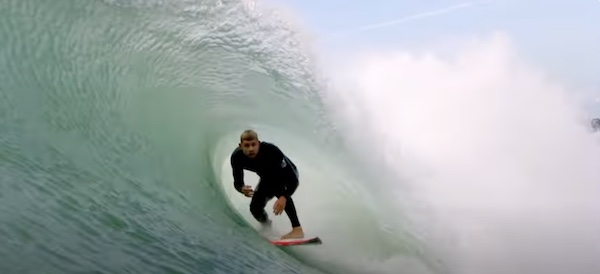At the time of this writing, the Surf Wing has been hard to come by. If you are lucky enough to get your hands on one, you are stoked. These beauties are in high demand with good reason. Similar to the foil board craze when they were introduced a few years back, there is a lot of hype and interest in the wing, but not a ton of inventory available for purchase. I put in my order months in advance. I hugged the UPS guy when the package finally arrived last Fall.
Naish Wing: Super Flashy or Innovation with Depth?
Like a lot of us, I wasn't sure what to make of the wing when I first saw Robby’s posts on Instagram. It was hard to tell whether it would be a flash in the pan or something with legs to last. Skeptical at first, I was nevertheless intrigued as many of my wind sport heroes sang the wing’s praises. Now that I finally had one in hand, it was time to form my own opinion.
In Burlington VT, a solid frontal system was scheduled to arrive that would deliver more than enough wind for my first session on the wing. The wing is versatile enough to be flown on a SUP or a foil. Either option is possible. The key is to match it with a board with enough volume to stand comfortably before the wind starts to pull you. Jumping on a 10'6 Naish Nalu on a light wind afternoon is a great introduction to the wing for most standup paddlers. A board of that volume and size allows one to get out on the water even when the wind is too strong for paddling. It’s a great place to start.
However, the ideal complement to the wing is your stand up paddle foil board. The same size board you use to stand up foil surf has now become even more valuable in the form of a wing surfing board as well.
Why the Wing is Worth the Wait: Less Rigging & One Great Ride
The wing is a perfect hybrid between windsurfing and kiting with the added benefit of a lot less gear and a quicker setup time. The single pump inflation system of the 4m Naish Surf Wing takes you from stuff-sack to ready-to-ride in less than a minute. It even comes with a pump and pressure gauge to dial in the perfect amount of air pressure. Once the wing is inflated, all you need to do is attach the wrist leash, grab your board, and head for the water. Compared to the level of effort in rigging a windsurfing sail or walking your kite lines, the rapid setup time of the wing is a huge plus.
Flying the wing couldn't be more intuitive - if you've done some kiting or windsurfing. The Naish Surf Wing has a multitude of handles to hold, giving plenty of options for gripping the wing and presenting it to the wind. The 4m wing size is ideal as it gives enough surface area to be meaningful while still small enough to keep the wing tips out of the water.
First Steps in Flying the Wing
The first time you jump on your board to leave shore, you'll want to take an angle across the wind and let the breeze fill the canopy. Keep your arms extended and angled above your shoulders to give the wind enough space to catch the wing. Be mindful of the lower wing tip as it may tend to drift downward and catch on the water. When this happens, it can spin the rig pretty violently and send you flying. Stay mindful of the lower wingtip. It is something you'll focus on initially, but will quickly become second nature.
To wing, you will move away from shore out to the wind line. Get familiar with learning how to pump the wing as you pump your board onto its foil. There's a technique to synchronizing that motion. As you load up the power in the wing, your lower body is coiling and extending that energy into the board as you pump yourself onto the foil. More wind makes that effort much easier. If the conditions are light, you'll be doing a lot of pumping, but once you're on foil you can stay on foil with a lot less wind. It’s a good idea to ride with your downwind foil setup using a large front wing with plenty of lift and glide to carry you through holes in the wind. I've experimented with a slightly smaller front wing and had to do a lot more pumping to stay on foil. Sizing your front wing really comes down to how much wind you have and how much work you want to do.
The wing performs best in a lot of wind - the windier, the better. It is also very friendly in gusty conditions relative to kiting and windsurfing. The bigger gusts will allow you to elevate your arms and extend your back elbow, releasing any wind you don't want. Your back arm does most of the work by changing the angle of the wing relative to the wind direction. It won't take long to feel the burn in your lats which will remind you it’s time to change direction. A lot of people are starting to experiment with harness lines that attach to the handles of the wing to maximize water time.
Just like kiting and windsurfing, the most fulfilling progression happens in the transitions. Learning to transition can be tricky on the foil, but the feeling of a well connected downwind carving gybe is amazing. There's a fluid connection between the wing and the foil as one cuts through the air while the other cuts a similar path through the water. Even the leading edge of both wing and foil are similar in their shape and the way they present themselves to the wind and water respectively.
On a Wing and Foil
It’s obvious that the wing was developed for the foil board. There were many initial failed prototypes of "wing-type" products that never quite materialized. But, with the popularity of the foil, the wing finally found a place in the product development that made sense. The foil is a perfect counterpart to the wing with the near-zero drag and lower force-to-speed ratio. You don't need a lot of force to stay on foil. You just need enough to keep a rider flying on foil. That’s why the small sail area of the wing works so well. Flying the wing with a standard SUP is possible and to be enjoyed by plenty of people looking to expand the utility of their standup paddle board. But it’s not the same experience as flying from your foil.
Once on foil, the feeling is very similar to kiting or windsurf foiling. You can sheet the wing in and out as needed to maintain your speed while pumping your board through the peaks and troughs of the wind swell. The foil cuts upwind easily which gives you a lot of room to ride up and down wind without losing any ground. Gaining upwind room gives the opportunity to search out a bump to ride without losing any real downwind ground.
Naish Wing: What Works
The biggest difference with the wing is its user-friendliness. The rig is insanely light especially when compared to the weight of a windsurfing rig. It can easily be "tucked" behind you when the opportunity to hop on a wave or jump on a bump presents itself. With the wing it’s also simple to release the rig if things go bad. We all remember the anxiety of being hooked to a giant kite on an overpowering day when we were learning to kite. The wing is way more forgiving. If things go badly, all you have to do is let go. The wrist leash that comes with the wing will keep it from blowing away and the re-launching process is much easier than uphauling a windsurfing rig or re-launching a kite.
The other really attractive feature of the Naish Surf Wing is that it packs up into a super small stuff-sack which makes it perfect for travel. Its size allows you to bring it along for those "just in case" adventures. You'd be crazy not to bring it with you anytime you're headed to the coast.
The Surf Wing comes with its own pump and hose which plugs into the streamlined SureLock valve on the leading edge of the wing. It takes less than a minute to pump the wing to maximum inflation. Naish built the canopy with the same Quad-Tex Ripstop fabric used in their kites, making the Surf Wing light, strong, and resilient against tears and rips. The generous amount of grab handles create plenty of options for holding and handling the wing. I felt most comfortable with a wide wing span particularly on the wing's trailing edge. With my back hand locked onto the rear handle, I felt I had better control over the wing and more power to sheet in when necessary.
Fast Learning Curve: Wing Foiling with a Pro
Most of my initial riding was done in the windy, chilly conditions of October on Lake Champlain in Burlington, Vermont. I was eager to put in as much time as possible before the winter temperatures arrived and shut me down for the season. I was also hustling to build enough competency to ride with my friend and Naish team rider Chuck Patterson, who planned to visit me in Rincon, Puerto Rico in early November. Chuck, already a huge fan of the Surf Wing, had been putting in his time on Maui to get things dialed and to sort out his own personal opinions regarding the wing. It didn't take long for him to be completely hooked on flying with the wing. This resulted in plenty of excited phone calls and text messages in anticipation of wing foiling together once in Puerto Rico.
Rincon sits at the most westerly tip of the island of Puerto Rico and generally receives steady offshore Carribean trade winds. Those easterly trades sweep across the north coast of the island and wrap around the northeastern corner, creating side off conditions on the west side. Standing on the beach in Rincon, Chuck and I could see a solid wind line of whitecaps ripping past the point only a mile or two from shore. We inflated the wings, launched our foil boards, and slowly tacked upwind toward the point. It didn't take long before we were past the point and ripping out to sea, riding the wind swell that was making its way down and around the west side of the island. Chuck was stoked. The anticipation and planning had paid off. Rincon proved to be an epic wing foiling spot!
After a few tacks, our buddy Jeff joined us on his windsurf foil which added an interesting perspective. Here was a sport that had been brand new only a few years ago and is still gaining popularity around the world, but in comparison to the wing on that given day, windsurf foiling was already looking like an old fling. How can that be? Is this even true?
The Rise of Watersport Innovations: New Ways to Be on the Water
New water sports seem to be developing at an extremely accelerated pace these days. It is difficult to master one sport before another emerges and focuses our attention on the next new, shiny object. Have we all become victims of short attention spans brought on by the over stimulating pace and exposure of social media? Or are we trying to diversify our skill sets in order to enjoy our water time in as many different ways as possible? Personally, I think it’s all about the ride. Every new sport is addictive, and none of them necessarily replace any of their predecessors.
The Naish Wing is a solid addition to anyone's quiver. It fits into the equation of possibilities of what to do on the water. We are so fortunate to have so many options when it comes to water sports equipment. It's especially nice when a new product like the Naish Wing allows riders to maximize the utility of the gear we already own. The wing wouldn't have received the market response it did without the wide adoption and excitement of the foil. That being said, there are all kinds of other boards like skateboards and snowboards that I'm eager to introduce to my new-found addiction. The idea of skimming across the snow and ice on a blade or board makes me excited about the upcoming winter.
However, these warm waters and strong Caribbean breezes are keeping my icy dreams on the back burner for now. There's plenty of time for me to freeze my tail off once I head back north. But for the moment, I'm interested in scoring a few more sessions on my foil board out on the point with the hopes of seeing a few humpback whales as they start their migration.

